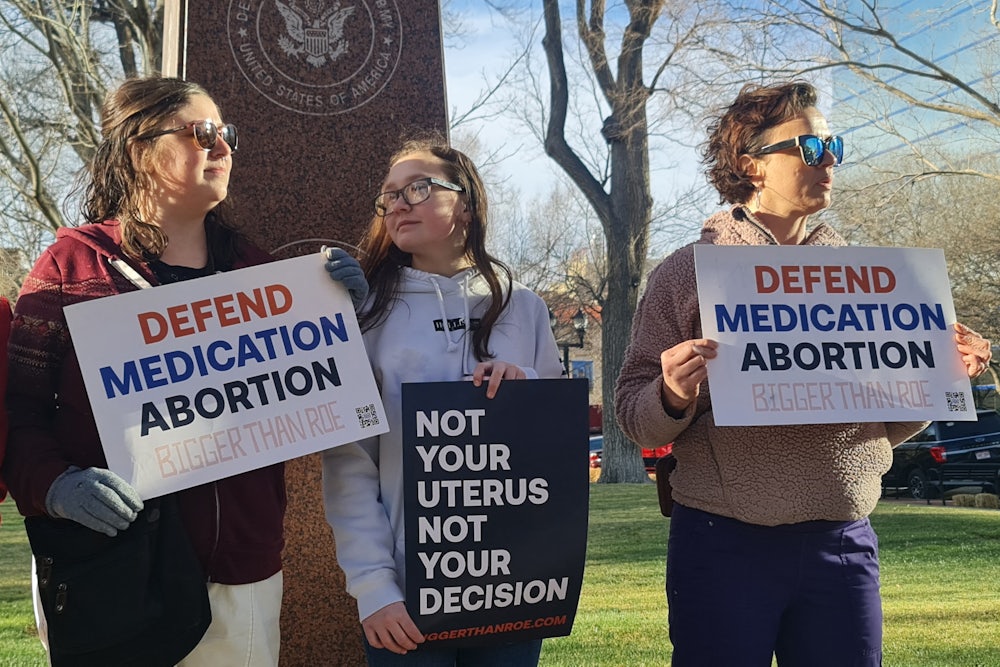The newest front line in the fight over abortion access is Amarillo, Texas, where a federal judge will soon determine whether to ban a widely used abortion medication. If Judge Matthew Kacsmaryk grants a preliminary injunction to limit the availability of the drug mifepristone, or remove it from the market altogether, abortion providers and advocates say that decision will sow confusion and further complicate abortion care.
In November, the Alliance for Hippocratic Medicine filed suit against the Food and Drug Administration with the goal of overturning its approval of mifepristone, which is part of a two-drug regimen for terminating a pregnancy that accounts for more than half of all abortions in the United States. The plaintiffs then filed a preliminary injunction to restrict or remove the drug from the market while Kacsmaryk decides the case. Kacsmaryk, who was appointed by President Donald Trump, has ties to conservative Christian groups and has previously expressed anti-abortion beliefs; critics contend that the Alliance for Hippocratic Medicine deliberately filed suit in Amarillo to have a more sympathetic judge preside over their case.
The impact of Kacsmaryk’s ruling could rival the Supreme Court’s decision in Dobbs v. Jackson Women’s Health Organization, which overturned Roe v. Wade. Every state would be affected by the removal of mifepristone from the market, even those that have recently strengthened the right to an abortion. A revival of the Comstock Act of 1873—which banned mailing anything related to contraception or abortion but was unenforced while Roe was in effect—could also have far-reaching effects.
“This ruling would have much broader ramifications, calling into question also the legality of other drugs and devices that are used in abortion care,” said Selina Sandoval, a practicing ob-gyn in Kansas and a fellow at Physicians for Reproductive Health. “It really just opens the door to significant limitations and other issues.”
In the two-drug regimen that’s currently the standard for medication abortion, mifepristone is followed 24 to 48 hours later by another drug, misoprostol. This method is effective for terminating a pregnancy 99.6 percent of the time. Twelve medical groups, including the American Medical Association and the American College of Obstetricians and Gynecologists, joined in an amicus brief saying that the drug is highly safe, with major adverse effects like hospitalization, blood loss, or infection occurring in fewer than 0.3 percent of patients. Mifepristone has been used by around five million women since its approval in 2000 and can also be used for miscarriage treatment.
The Alliance for Hippocratic Medicine has also asked the court to overturn some of the more recent actions the FDA has taken on mifepristone, including approving a generic version in 2019 and allowing the medication to be delivered by mail in 2021. Lawyers for the group argued before Kacsmaryk last week that medical abortion causes “cramping, heavy bleeding, and severe pain.” But lawyers for the FDA and the company that manufactures mifepristone countered that the process of terminating a pregnancy often results in bleeding and cramping, and pointed to the significant scientific evidence that the drug is safe to use.
“There’s absolutely no reason to consider a ban, other than a political one,” said Melissa Grant, the COO and co-founder of Carafem, an organization that offers online and in-person abortion care. If Kacsmaryk grants the injunction, that does not mean mifepristone is unsafe, Grant said; instead, “the only risk that’s posed as a result of this decision is a legal risk to people across the country to criminalize those who seek abortion care or those who provide it.”
It’s possible to use misoprostol alone to terminate a pregnancy, a regimen that one study calls a “reasonable option” for those seeking an abortion in the first trimester, while also “clearly less effective than standard regimens that also contain mifepristone.” But taking misoprostol on its own can “prolong the process,” said Sandoval. A misoprostol-only regimen requires a higher dosage, and people may subsequently experience stronger side effects.
“Although the method is still very safe, it’s not as convenient and not as fast as a process for patients, and comes with some more side effects,” Sandoval said. The success rate for a misoprostol-only regimen also ranges from 84 to 96 percent, lower than the rate for the two-drug method.
In anticipation of a threat to mifepristone access, Carafem has been offering the misoprostol-only method as an option since 2020. If mifepristone is removed from the market, patients seeking abortion care through Carafem will still be able to use misoprostol alone, but it is not the “gold standard” method, Grant said.
“The sad part of this is that, in a country as developed as the U.S., it sure seems we should be giving people the best and most proven medications that are available, and not the second-best option,” Grant said. “Our hope is that we would not have to completely stop providing care, but it would change the way that we provide care, potentially very abruptly.” Hey Jane, another organization which provides online abortion care, is also “prepared to shift” to offering misoprostol alone, CEO and co-founder Kiki Freedman told me in an email.
It may take some time for mifepristone to be fully removed from the market if Kacsmaryk asks the FDA to do so. “We firmly believe the judge’s power is limited and his ruling will not have the power to stop the distribution of mifepristone immediately,” Freedman said.
But the decision could also sow further confusion about what kind of abortion treatments are available, said Rebecca Wang, legal support counsel at If/When/How, an advocacy network that provides legal advice regarding abortion access.
“As part of all of these various abortion restrictions we’ve seen, we know that it makes people question whether anything they do is legal,” Wang said. “We definitely have people questioning, ‘Can I even talk about abortion? Can I share abortion resources? Can I leave my state to seek care?’”
Abortion clinics, many of which have already been overwhelmed in the wake of the Dobbs decision, would also feel the day-to-day effect of decreasing access to medication abortion. More people will seek procedural abortions, putting a strain on clinics and increasing wait times for procedures. Those longer wait times could, in turn, result in abortions occurring later in pregnancy. “That’s the point of the ban, is to try to prevent these patients from getting in to be seen and having the safest abortion they could have possible,” Sandoval argued.
There’s also a chance that, as medication abortion becomes less available to people seeking to terminate their pregnancies, they turn to alternative methods for doing so outside of legal channels. Due to the confusion about legality, physicians may choose not to offer the misoprostol-only regimen, which could in turn lead to more people seeking to self-manage their abortion care. The struggles of obtaining an abortion through a physical procedure—such long wait times, cost, or distance—could also encourage self-management.
“Anytime there are restrictions of clinical abortion care in the United States, we know more people become interested in self-managing, exploring that as a route or preferring that as an option. And self-managed abortion is still criminalized in the U.S.,” Wang said.
As the attorneys for the FDA and Danco Laboratories, which manufactures mifepristone, argued before Kacsmaryk last week, revoking approval for a drug that has been widely used for two decades will have dramatic consequences that perhaps cannot be fully foreseen.
“This injunction is not about upholding the status quo,” said Jessica Ellsworth, an attorney for Danco. “They want very much to upend the status quo.”










